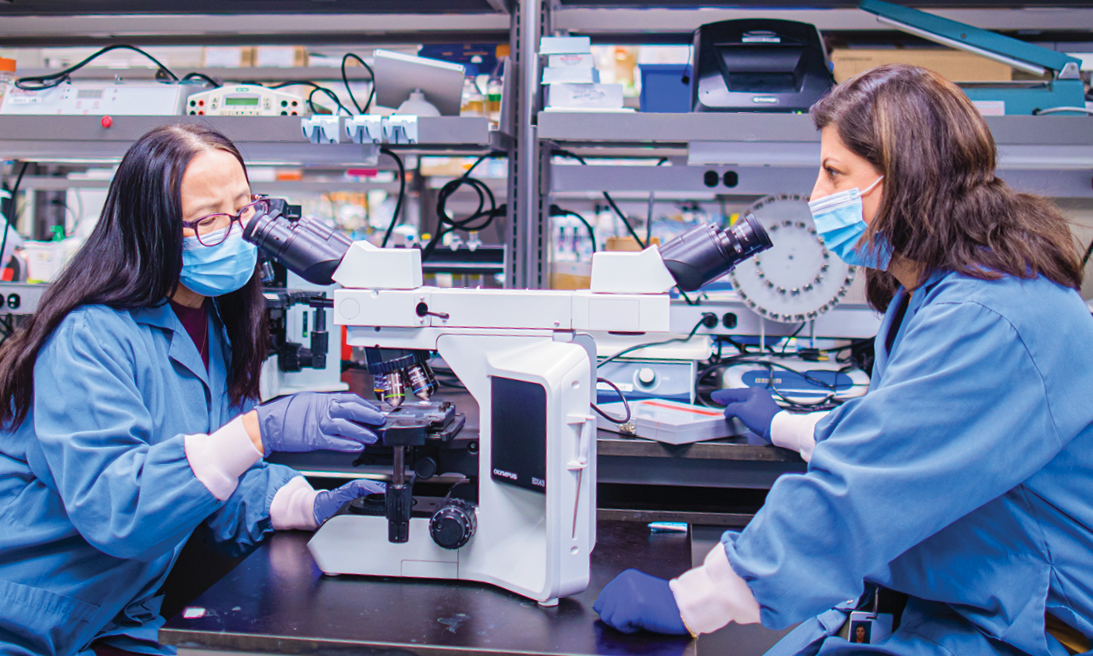Minoo Mohajer had a meningioma, which put pressure on her brain as it grew. (Photo: Tim Fraser)
By Glynis Ratcliffe
When Minoo Mohajer was introduced to Dr. Gelareh Zadeh through the Iranian community in 2018, it was with the idea of helping raise money for Dr. Zadeh’s lab at University Health Network’s (UHN’s) Krembil Brain Institute. Mohajer was proud that a fellow Iranian-Canadian was performing such important work and offered to host a fundraiser with her husband. Not long after, Dr. Zadeh gave the couple a tour of her lab, which focuses on conducting genomic and epigenomic analysis of brain tumours to improve patient treatments. Four years later, Mohajer would become a patient at the lab herself.
In January 2022, Mohajer was visiting family in San Diego when she felt tingling on one side of her head and lips, and then numbness in her fingers on her right hand to the point where she couldn’t move them for nearly a minute. It quickly disappeared, so she chalked it up to pandemic-related stress. But in the following weeks, her brother-in-law, a retired surgeon, saw her shaking her hands to get the feeling back in her fingers. When Mohajer mentioned the recurring sensations, he suggested that something on her spine or brain could be causing the symptoms. When symptoms worsened in July, the neurologist she was seeing in Toronto set up an emergency MRI, worried that a seizure might be next.
Mohajer had an often-benign tumour called a meningioma in her meninges, which are the three outer membranes that protect the brain and spinal cord. Meningiomas develop along the middle membrane, called the arachnoid, a web-like structure meant to cushion the brain. Mohajer’s tumour had likely been there for years, but it was now growing rapidly and needed to be removed immediately.

A benign tumour that can turn aggressive
Thinking back to the meeting four years earlier, Mohajer decided to ask her doctor for a referral to Dr. Zadeh, who is Head of the Division of Neurosurgery in the Sprott Department of Surgery, the Dan Family Chair in Neurosurgery, Harold & Esther Halpern Chair in Neurosurgery and the Wilkins Family Chair in Neurosurgical Brain Tumour Research at UHN.
Dr. Zadeh, who is also Medical Director of Krembil Brain Institute at UHN, found Mohajer’s tumour had invaded an area next to her motor cortex, a structure that controls the movement of her arm and leg. “That’s where these tumours become challenging,” she says. “Sometimes as they grow and push on the brain, tumours can start invading almost like roots into the brain. They become integrated into the brain matter.”
Although not cancerous, these types of meningiomas are more likely to grow back since they are often too close to important blood vessels or structures to remove entirely. The challenge is determining which ones need further treatment, like radiation, and whether continued monitoring can differentiate between scar tissue and tumour recurrence. Early detection of a reoccurrence can be tricky, as an MRI can only identify tumours that have reached a critical mass of about 10 million cells, or one centimetre in diameter.

That’s where Dr. Zadeh’s lab is helping. The lab is large, both in terms of the number of team members and the amount of funding they need for research – one DNA methylation machine runs upwards of $300,000. “We are like an incubator,” says Qingxia Wei, a scientist in Dr. Zadeh’s lab who oversees the neurosurgery residents, fellows and graduate students and helps ensure the work in the lab is as productive and efficient as possible. “Our lab is helping residents and fellows to fulfil their dreams and further life-saving research.”
Decoding a tumour’s DNA
Understanding and predicting the behaviour of brain tumours like the one Mohajer has requires in-depth analysis of everything from the patient’s medical history to tumour imaging to biomarkers. Sheila Mansouri, another scientist in Dr. Zadeh’s lab, explains: “Basically, we’re going back and forth between these different types of analysis and then trying to find the best and least aggressive way to treat the patients.”
Mohajer underwent brain surgery in September 2022, during which Dr. Zadeh successfully removed the tumour. A sample from the tumour is now undergoing DNA methylation profiling to better determine whether the tumour is benign or aggressive. The lab can also monitor tumour growth and reoccurrence with just a liquid biopsy or blood sample, which, Wei explains, is far less invasive than regular tumour biopsies. The process isn’t covered by OHIP, but costs are taken care of for those who need the tests, thanks to support from UHN Foundation and its donors.
– Source: UHN6,000+
Number of brain tumour specimens stored in the Nervous System Tumour Bank in Dr. Zadeh’s lab.
“The more samples we have, the more accurate our results will be,” explains Mansouri. Right now, the lab’s brain tumour bank holds more than 6,000 samples, the only repository of its kind. It’s also one of a handful of labs in North America to perform DNA methylation of brain tumours. That this type of scientific research can be translated into clinical practice is due in large part to the multidisciplinary team at UHN, says Dr. Zadeh. “Without their acceptance, adoption and recognition of the value of this research, none of this would be possible.”
As for Mohajer, she’s grateful to be in such competent hands. “It’s just amazing they have access to this kind of technology and diagnostic tools,” she says. “I feel very lucky.”
This article originally appeared in the 2023 issue of the Sprott Department of Surgery magazine. Read it here.


